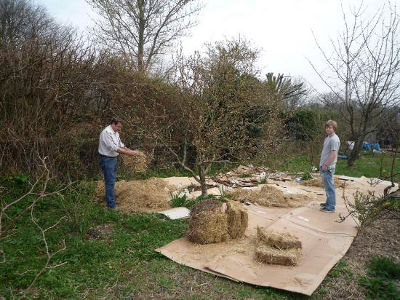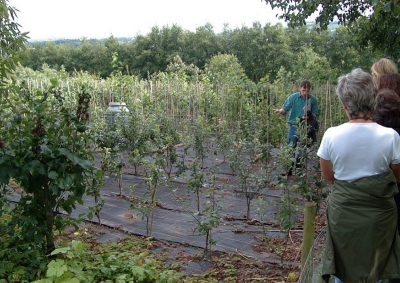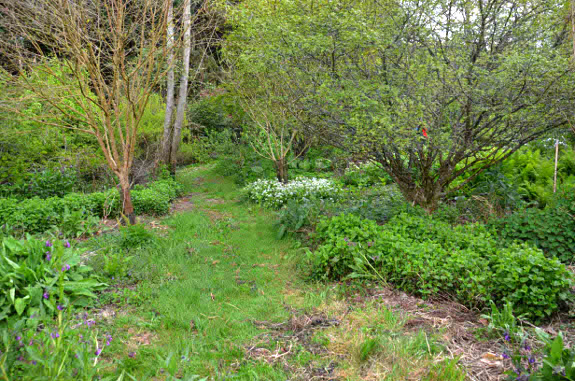
How to start a forest garden from scratch
Although I geekily
enjoyed the numbers in the
fertility chapter,
what I wish I'd read four years ago was Crawford's simple advice for
starting a forest garden from scratch. First of all, he
recommends that you kill all of the weedy perennials (like brambles and
trees) before doing anything else --- that tip alone could have saved
me lots of pain and suffering. Simply mowing regularly for a year
or two usually does the trick.
 Assuming your blank slate
consists of a grassy field, Crawford recommends planting the canopy
trees, then slowly kill mulching bands of earth to be filled with
smaller plants a year later. On Crawford's large scale, plastic
landscape fabric makes sense as the kill layer, but for most of us, I'd
instead recommend simple kill mulches made of cardboard and woody
mulches as a way of boosting our soil fertility and keeping
microorganisms happy. Regardless of what you use to kill the
grass, Martin's technique is a bit like the "islands that merge" pattern in Edible
Forest Gardens,
which I've adopted as my own method of building a forest garden.
Assuming your blank slate
consists of a grassy field, Crawford recommends planting the canopy
trees, then slowly kill mulching bands of earth to be filled with
smaller plants a year later. On Crawford's large scale, plastic
landscape fabric makes sense as the kill layer, but for most of us, I'd
instead recommend simple kill mulches made of cardboard and woody
mulches as a way of boosting our soil fertility and keeping
microorganisms happy. Regardless of what you use to kill the
grass, Martin's technique is a bit like the "islands that merge" pattern in Edible
Forest Gardens,
which I've adopted as my own method of building a forest garden.
 The benefit of this
a-bit-at-a-time system is that you can slowly propagate all of the
extra plants you need, filling in one area per year, while maintaining
the parts you haven't gotten to yet with a few yearly rounds of
mowing. Alternatively, you can till the space up and plant a
perennial cover crop to take the place of grass in areas waiting to be
planted with the permanent understory. (Or grow vegetables there.)
The benefit of this
a-bit-at-a-time system is that you can slowly propagate all of the
extra plants you need, filling in one area per year, while maintaining
the parts you haven't gotten to yet with a few yearly rounds of
mowing. Alternatively, you can till the space up and plant a
perennial cover crop to take the place of grass in areas waiting to be
planted with the permanent understory. (Or grow vegetables there.)
Using this technique,
Crawford estimates you'll need to devote about 5.5 days per 1,000
square feet of forest garden during the design and establishment
phase. (Maintenance takes him another 2 days per 1,000 square
feet per year.) Your final forest garden will have all the pieces
in place after two to ten years, and he tells us not to worry if the
forest garden doesn't look like much at first. Photos on the
internet of Crawford's garden suggest that it's quite possible to
create a beautiful and productive space using his methods if you just
keep plugging right along.
| This post is part of our Creating a Forest Garden lunchtime series.
Read all of the entries: |
Want more in-depth information? Browse through our books.
Or explore more posts by date or by subject.
About us: Anna Hess and Mark Hamilton spent over a decade living self-sufficiently in the mountains of Virginia before moving north to start over from scratch in the foothills of Ohio. They've experimented with permaculture, no-till gardening, trailersteading, home-based microbusinesses and much more, writing about their adventures in both blogs and books.
Want to be notified when new comments are posted on this page? Click on the RSS button after you add a comment to subscribe to the comment feed, or simply check the box beside "email replies to me" while writing your comment.
- Remove comment

